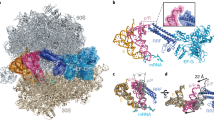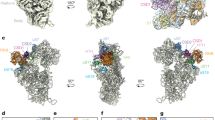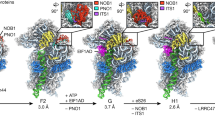Abstract
In the final steps of yeast ribosome synthesis, immature translation-incompetent pre-40S particles that contain 20S pre-rRNA are converted to the mature translation-competent subunits containing the 18S rRNA. An assay for 20S pre-rRNA cleavage in purified pre-40S particles showed that cleavage by the PIN domain endonuclease Nob1 was strongly stimulated by the GTPase activity of Fun12, the yeast homolog of cytoplasmic translation initiation factor eIF5b. Cleavage of the 20S pre-rRNA was also inhibited in vivo and in vitro by blocking binding of Fun12 to the 25S rRNA through specific methylation of its binding site. Cleavage competent pre-40S particles stably associated with Fun12 and formed 80S complexes with 60S ribosomal subunits. We propose that recruitment of 60S subunits promotes GTP hydrolysis by Fun12, leading to structural rearrangements within the pre-40S particle that bring Nob1 and the pre-rRNA cleavage site together.
This is a preview of subscription content, access via your institution
Access options
Subscribe to this journal
Receive 12 print issues and online access
$189.00 per year
only $15.75 per issue
Buy this article
- Purchase on Springer Link
- Instant access to full article PDF
Prices may be subject to local taxes which are calculated during checkout








Similar content being viewed by others
Accession codes
References
Inoue, K., Alsina, J., Chen, J. & Inouye, M. Suppression of defective ribosome assembly in a rbfA deletion mutant by overexpression of Era, an essential GTPase in Escherichia coli. Mol. Microbiol. 48, 1005–1016 (2003).
Granneman, S., Petfalski, E., Swiatkowska, A. & Tollervey, D. Cracking pre-40S ribosomal subunit structure by systematic analyses of RNA-protein cross-linking. EMBO J. 29, 2026–2036 (2010).
Li, Z. et al. Rational extension of the ribosome biogenesis pathway using network-guided genetics. PLoS Biol. 7, e1000213 (2009).
Campbell, T.L. & Brown, E.D. Genetic interaction screens with ordered overexpression and deletion clone sets implicate the Escherichia coli GTPase YjeQ in late ribosome biogenesis. J. Bacteriol. 190, 2537–2545 (2008).
Lo, K.Y. et al. Defining the pathway of cytoplasmic maturation of the 60S ribosomal subunit. Mol. Cell 39, 196–208 (2010).
Sengupta, J. et al. Characterization of the nuclear export adaptor protein Nmd3 in association with the 60S ribosomal subunit. J. Cell Biol. 189, 1079–1086 (2010).
Kemmler, S., Occhipinti, L., Veisu, M. & Panse, V.G. Yvh1 is required for a late maturation step in the 60S biogenesis pathway. J. Cell Biol. 186, 863–880 (2009).
Strunk, B.S. et al. Ribosome assembly factors prevent premature translation initiation by 40S assembly intermediates. Science 333, 1449–1453 (2011).
Panse, V.G. & Johnson, A.W. Maturation of eukaryotic ribosomes: acquisition of functionality. Trends Biochem. Sci. 35, 260–266 (2010).
Soudet, J., Gelugne, J.P., Belhabich-Baumas, K., Caizergues-Ferrer, M. & Mougin, A. Immature small ribosomal subunits can engage in translation initiation in Saccharomyces cerevisiae. EMBO J. 29, 80–92 (2010).
Pertschy, B. et al. RNA helicase Prp43 and its co-factor Pfa1 promote 20 to 18 S rRNA processing catalyzed by the endonuclease Nob1. J. Biol. Chem. 284, 35079–35091 (2009).
Fatica, A., Oeffinger, M., Dlakic, M. & Tollervey, D. Nob1p is required for cleavage of the 3′ end of 18S rRNA. Mol. Cell. Biol. 23, 1798–1807 (2003).
Fatica, A., Tollervey, D. & Dlakic, M. The PIN domain of Nob1p is required for 20S pre-rRNA cleavage at site D. RNA 10, 1698–1701 (2004).
Lamanna, A.C. & Karbstein, K. Nob1 binds the single-stranded cleavage site D at the 3′-end of 18S rRNA with its PIN domain. Proc. Natl. Acad. Sci. USA 106, 14259–14264 (2009).
Woolls, H.A., Lamanna, A.C. & Karbstein, K. Roles of Dim2 in ribosome assembly. J. Biol. Chem. 286, 2578–2586 (2011).
Lebaron, S. et al. The ATPase and helicase activities of Prp43p are stimulated by the G-patch protein Pfa1p during yeast ribosome biogenesis. EMBO J. 28, 3808–3819 (2009).
Lamanna, A.C. & Karbstein, K. An RNA conformational switch regulates pre-18S rRNA cleavage. J. Mol. Biol. 405, 3–17 (2011).
Allmang, C. et al. Processing of the yeast pre-rRNA at sites A2 and A3 is linked. RNA 2, 63–73 (1996).
Yeh, L.-C.C., Thweatt, R. & Lee, J.C. Internal transcribed spacer 1 of the yeast precursor ribosomal RNA. Higher order structure and common structural motifs. Biochemistry 29, 5911–5918 (1990).
Van Nues, R.W. et al. Separate structural elements within internal transcribed spacer 1 of Saccharomyces cerevisiae precursor ribosomal RNA direct the formation of 17S and 26S rRNA. Nucleic Acids Res. 22, 912–919 (1994).
Gelperin, D., Horton, L., Beckman, J., Hensold, J. & Lemmon, S.K. Bms1p, a novel GTP-binding protein, and the related Tsr1p are required for distinct steps of 40S ribosome biogenesis in yeast. RNA 7, 1268–1283 (2001).
Lee, J.H. et al. Initiation factor eIF5B catalyzes second GTP-dependent step in eukaryotic translation initiation. Proc. Natl. Acad. Sci. USA 99, 16689–16694 (2002).
Pestova, T.V. et al. The joining of ribosomal subunits in eukaryotes requires eIF5B. Nature 403, 332–335 (2000).
Ferreira-Cerca, S. et al. Analysis of the in vivo assembly pathway of eukaryotic 40S ribosomal proteins. Mol. Cell 28, 446–457 (2007).
Udem, S.A. & Warner, J.R. The cytoplasmic maturation of a ribosomal precursor ribonucleic acid in yeast. J. Biol. Chem. 248, 1412–1416 (1973).
Brand, R.C., Klootwijk, J., van Steenbergen, T.J.M., de Kok, A.J. & Planta, R.J. Secondary methylation of yeast ribosomal precursor RNA. Eur. J. Biochem. 75, 311–318 (1977).
Lafontaine, D., Delcour, J., Glasser, A.-L., Desgrès, J. & Vandenhaute, J. The DIM1 gene responsible for the conserved m26Am26A dimethylation in the 3′-terminal loop of 18S rRNA is essential in yeast. J. Mol. Biol. 241, 492–497 (1994).
van Nues, R.W. et al. Box C/D snoRNP catalysed methylation is aided by additional pre-rRNA base-pairing. EMBO J. 30, 2420–2430 (2011).
Unbehaun, A. et al. Position of eukaryotic initiation factor eIF5B on the 80S ribosome mapped by directed hydroxyl radical probing. EMBO J. 26, 3109–3123 (2007).
Shin, B.-S. et al. rRNA suppressor of a eukaryotic translation initiation factor 5B/Initiation factor 2 mutant reveals a binding site for translational GTPases on the small ribosomal subunit. Mol. Cell. Biol. 29, 808–821 (2009).
Decatur, W.A. & Fournier, M.J. rRNA modifications and ribosome function. Trends Biochem. Sci. 27, 344–351 (2002).
Lygerou, Z., Allmang, C., Tollervey, D. & Séraphin, B. Accurate processing of a eukaryotic pre-rRNA by RNase MRP in vitro. Science 272, 268–270 (1996).
Abou Elela, S., Igel, H. & Ares, M. Jr. RNase III cleaves eukaryotic preribosomal RNA at a U3 snoRNP-dependent site. Cell 85, 115–124 (1996).
Horn, D.M., Mason, S.L. & Karbstein, K. Rcl1 protein, a novel nuclease for 18 S ribosomal RNA production. J. Biol. Chem. 286, 34082–34087 (2011).
Allmang, C. & Tollervey, D. The role of the 3′ external transcribed spacer in yeast pre-rRNA processing. J. Mol. Biol. 278, 67–78 (1998).
Valasek, L., Hasek, J., Nielsen, K.H. & Hinnebusch, A.G. Dual function of eIF3j/Hcr1p in processing 20 S pre-rRNA and translation initiation. J. Biol. Chem. 276, 43351–43360 (2001).
Collins, S.R. et al. Toward a comprehensive atlas of the physical interactome of Saccharomyces cerevisiae. Mol. Cell. Proteomics 6, 439–450 (2007).
Senger, B. et al. The nucle(ol)ar Tif6p and Efl1p are required for a late cytoplasmic step of ribosome synthesis. Mol. Cell 8, 1363–1373 (2001).
Yarunin, A. et al. Functional link between ribosome formation and biogenesis of iron-sulfur proteins. EMBO J. 24, 580–588 (2005).
Neueder, A. et al. A local role for the small ribosomal subunit primary binder rpS5 in final 18S rRNA processing in yeast. PLoS ONE 5, e10194 (2010).
Veith, T. et al. Structural and functional analysis of the archaeal endonuclease Nob1. Nucleic Acids Res. 40, 3259–3274 (2012).
Marshall, R.A., Aitken, C.E. & Puglisi, J.D. GTP hydrolysis by IF2 guides progression of the ribosome into elongation. Mol. Cell 35, 37–47 (2009).
Julian, P. et al. The cryo-EM structure of a complete 30S translation initiation complex from Escherichia coli. PLoS Biol. 9, e1001095 (2011).
La Teana, A., Gualerzi, C.O. & Brimacombe, R. From stand-by to decoding site. Adjustment of the mRNA on the 30S ribosomal subunit under the influence of the initiation factors. RNA 1, 772–782 (1995).
Valle, M. et al. Locking and unlocking of ribosomal motions. Cell 114, 123–134 (2003).
Mangiarotti, G., Chiaberge, S. & Bulfone, S. rRNA maturation as a “quality” control step in ribosomal subunit assembly in Dictyostelium discoideum. J. Biol. Chem. 272, 27818–27822 (1997).
Kaczanowska, M. & Ryden-Aulin, M. Ribosome biogenesis and the translation process in Escherichia coli. Microbiol. Mol. Biol. Rev. 71, 477–494 (2007).
Belotserkovsky, J.M., Dabbs, E.R. & Isaksson, L.A. Mutations in 16S rRNA that suppress cold-sensitive initiation factor 1 affect ribosomal subunit association. FEBS J. 278, 3508–3517 (2011).
Ben-Shem, A. et al. The structure of the eukaryotic ribosome at 3.0 A resolution. Science 334, 1524–1529 (2011).
Brachmann, C.B. et al. Designer deletion strains derived from Saccharomyces cerevisiae S288C: a useful set of strains and plasmids for PCR-mediated gene disruption and other applications. Yeast 14, 115–132 (1998).
Petracek, M.E. & Longtine, M.S. PCR-based engineering of yeast genome. Methods Enzymol. 350, 445–469 (2002).
Bohnsack, M.T. et al. Prp43 bound at different sites on the pre-rRNA performs distinct functions in ribosome synthesis. Mol. Cell 36, 583–592 (2009).
Karbstein, K., Jonas, S. & Doudna, J.A. An essential GTPase promotes assembly of preribosomal RNA processing complexes. Mol. Cell 20, 633–643 (2005).
Granneman, S., Kudla, G., Petfalski, E. & Tollervey, D. Identification of protein binding sites on U3 snoRNA and pre-rRNA by UV cross-linking and high throughput analysis of cDNAs. Proc. Natl. Acad. Sci. USA 106, 9613–9618 (2009).
Lebaron, S. et al. The splicing ATPase prp43p is a component of multiple preribosomal particles. Mol. Cell. Biol. 25, 9269–9282 (2005).
Tollervey, D. High level of complexity of small nuclear RNAs from fungi and plants. J. Mol. Biol. 196, 355–361 (1987).
Leshin, J.A., Rakauskaite, R., Dinman, J.D. & Meskauskas, A. Enhanced purity, activity and structural integrity of yeast ribosomes purified using a general chromatographic method. RNA Biol. 7, 354–360 (2010).
Roll-Mecak, A., Cao, C., Dever, T.E. & Burley, S.K. X-ray structures of the universal translation initiation factor IF2/eIF5B: conformational changes on GDP and GTP binding. Cell 103, 781–792 (2000).
Acknowledgements
This work was supported by the Wellcome Trust (S.L., C.S., S.G. and D.T., 077248; R.W.v.N. and N.J.W., WT089378MA), the Royal Society (C.S.), The Darwin Trust of Edinburgh (B.B.) and an European Molecular Biology Organisation Long-Term Fellowship (S.L.). The electron microscopy facility was supported by the Wellcome Trust and the Scottish Universities Life Sciences Alliance. Work in the Wellcome Trust Centre for Cell Biology is supported by Wellcome Trust core funding (092076). We thank E. Fayet-Lebaron for her technical support and critical reading of the manuscript. We thank members of the Edinburgh Protein Production Facility for protein purification. Use of the Edinburgh Protein Production Facility was supported by The Wellcome Trust, the Scottish Universities Life Sciences Alliance and the Biotechnology and Biological Sciences Research Council.
Author information
Authors and Affiliations
Contributions
S.L., C.S., R.W.v.N., A.S., S.G., N.J.W. and D.T. designed experiments; S.L., C.S., R.W.v.N., A.S., D.W., B.B. and S.G. performed experiments; S.L., C.S., R.W.v.N., A.S., B.B., S.G., N.J.W. and D.T. analyzed data; and S.L., C.S., R.W.v.N., A.S., S.G., N.J.W. and D.T. wrote the paper.
Corresponding author
Ethics declarations
Competing interests
The authors declare no competing financial interests.
Supplementary information
Supplementary Text and Figures
Supplementary Figures 1–5, Supplementary Tables 1–2 and Supplementary Note (PDF 9758 kb)
Rights and permissions
About this article
Cite this article
Lebaron, S., Schneider, C., van Nues, R. et al. Proofreading of pre-40S ribosome maturation by a translation initiation factor and 60S subunits. Nat Struct Mol Biol 19, 744–753 (2012). https://doi.org/10.1038/nsmb.2308
Received:
Accepted:
Published:
Issue Date:
DOI: https://doi.org/10.1038/nsmb.2308
This article is cited by
-
Domain definition and preliminary functional exploration of the endonuclease NOBP-1 in Strongyloides stercoralis
Parasites & Vectors (2023)
-
Kaposi’s sarcoma-associated herpesvirus induces specialised ribosomes to efficiently translate viral lytic mRNAs
Nature Communications (2023)
-
Conserved phosphorylation hotspots in eukaryotic protein domain families
Nature Communications (2019)
-
Crystal structures of Rea1-MIDAS bound to its ribosome assembly factor ligands resembling integrin–ligand-type complexes
Nature Communications (2019)
-
Ribosome assembly coming into focus
Nature Reviews Molecular Cell Biology (2019)



